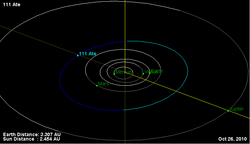Astronomy:111 Ate
 Orbital diagram | |
| Discovery | |
|---|---|
| Discovered by | Christian Heinrich Friedrich Peters |
| Discovery date | 14 August 1870 |
| Designations | |
| (111) Ate | |
| Pronunciation | /ˈeɪtiː/[1] |
| Named after | Ate |
| A870 PA; 1911 KE; 1935 AA | |
| Minor planet category | Main belt |
| Orbital characteristics[2] | |
| Epoch 31 July 2016 (JD 2457600.5) | |
| Uncertainty parameter 0 | |
| Observation arc | 145.66 yr (53202 d) |
| |{{{apsis}}}|helion}} | 2.8614 astronomical unit|AU (428.06 Gm) |
| |{{{apsis}}}|helion}} | 2.32553 AU (347.894 Gm) |
| 2.59349 AU (387.981 Gm) | |
| Eccentricity | 0.10332 |
| Orbital period | 4.18 yr (1525.5 d) |
| Average Orbital speed | 18.44 km/s |
| Mean anomaly | 190.607° |
| Mean motion | 0° 14m 9.532s / day |
| Inclination | 4.9318° |
| Longitude of ascending node | 305.757° |
| 166.424° | |
| Earth MOID | 1.34088 AU (200.593 Gm) |
| Jupiter MOID | 2.23131 AU (333.799 Gm) |
| TJupiter | 3.406 |
| Physical characteristics | |
| Dimensions | 126.34 km[2] 142.85 ± 5.94 km[3] |
| Mass | (1.76 ± 0.44) × 1018 kg[3] |
| Mean density | 1.15 ± 0.32 g/cm3[3] |
Equatorial surface gravity | 0.0376 m/s² |
Equatorial escape velocity | 0.0712 km/s |
| Rotation period | 22.072 h (0.9197 d)[2] 22.072 ± 0.001 h[4] |
| Geometric albedo | 0.0605±0.004 |
| Physics | ~173 K |
| C[5] | |
| Absolute magnitude (H) | 8.02 |
Ate (minor planet designation: 111 Ate) is a main-belt asteroid discovered by the German-American astronomer C. H. F. Peters on August 14, 1870,[6] and named after Ate, the goddess of mischief and destruction in Greek mythology. In the Tholen classification system, it is categorized as a carbonaceous C-type asteroid, while the Bus asteroid taxonomy system lists it as an Ch asteroid.[5]
Two stellar occultations by Ate were observed in 2000, two months apart. Its occultation of the star HIP 2559 was used to determine a chord length of 125.6 ± 7.2 km through the asteroid, giving a lower bound on the maximum dimension.[7] During 2000, 111 Ate was observed by radar from the Arecibo Observatory. The return signal matched an effective diameter of 135 ± 15 km.[8] The estimated size of this asteroid is 143 km,[3] making it one of the larger asteroids.
Based upon an irregular light curve generated from photometric observations of this asteroid at Pulkovo Observatory, it has a rotation period of 22.072 ± 0.001 hours and varies in brightness by 0.12 ± 0.01 in magnitude.[4]
References
- ↑ Noah Webster (1884) A Practical Dictionary of the English Language
- ↑ 2.0 2.1 2.2 Yeomans, Donald K., "111 Ate", JPL Small-Body Database Browser (NASA Jet Propulsion Laboratory), https://ssd.jpl.nasa.gov/sbdb.cgi?sstr=111, retrieved 12 May 2016.
- ↑ 3.0 3.1 3.2 3.3 Carry, B. (December 2012), "Density of asteroids", Planetary and Space Science 73: pp. 98–118, doi:10.1016/j.pss.2012.03.009, Bibcode: 2012P&SS...73...98C. See Table 1.
- ↑ 4.0 4.1 Pilcher, Frederick (October 2011), "Rotation Period Determinations for 11 Parthenope, 38 Leda, 111 Ate 194 Prokne, 217 Eudora, and 224 Oceana", The Minor Planet Bulletin 38 (4): pp. 183–185, Bibcode: 2011MPBu...38..183P.
- ↑ 5.0 5.1 DeMeo, Francesca E. et al. (July 2009), "An extension of the Bus asteroid taxonomy into the near-infrared", Icarus 202 (1): pp. 160–180, doi:10.1016/j.icarus.2009.02.005, Bibcode: 2009Icar..202..160D, archived from the original on 2014-03-17, https://web.archive.org/web/20140317200310/https://www.tara.tcd.ie/bitstream/2262/43276/1/PEER_stage2_10.1016/j.icarus.2009.02.005.pdf, retrieved 2013-04-08. See appendix A.
- ↑ "Numbered Minor Planets 1–5000", Discovery Circumstances (IAU Minor Planet center), https://www.minorplanetcenter.net/iau/lists/NumberedMPs000001.html, retrieved 2013-04-07.
- ↑ Devyatkin, A. V. et al. (November 2008), "Photometric observations of solar system bodies with ZA-320M automatic mirror astrograph in Pulkovo observatory", Planetary and Space Science 56 (14): pp. 1888–1892, doi:10.1016/j.pss.2008.02.014, Bibcode: 2008P&SS...56.1888D. See Table 1.
- ↑ Magri, Christopher et al. (January 2007), "A radar survey of main-belt asteroids: Arecibo observations of 55 objects during 1999–2003", Icarus 186 (1): 126–151, doi:10.1016/j.icarus.2006.08.018, Bibcode: 2007Icar..186..126M
External links
- 111 Ate at AstDyS-2, Asteroids—Dynamic Site
- 111 Ate at the JPL Small-Body Database
 |

